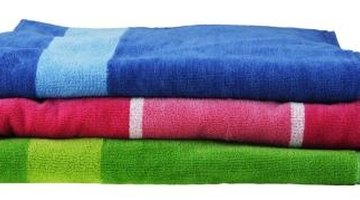How to Stop Color Bleeding When Washing Wools
Color bleeding causes white garments to turn pink from red garments or turn gray from dark denim. Excess fabric dye bleeds out of one garment and another absorbs it, resulting in a dye-transfer stain. Dry-transfer stains are difficult to remove, so avoidance is the best and most efficient tactic when doing laundry. Because it's a natural fiber, wool requires special care to avoid shrinkage or other damage. Special precautions must be taken while preventing color bleed when washing wool garments.

-
Separate your wool garments by color, just as you would with other laundry. Divide wools into a load of light-colored garments and a load of dark-colored garments. Separate out bright colors, such as red, from the dark-colored garment pile.
-
Fill a bucket with undiluted white vinegar. Soak each wool garment in the vinegar for 10 to 15 minutes to set the fabric dye. Rinse with warm water.
-
Rinse the bucket and fill with warm water and two caps full of mild detergent made for washing wool. Submerge your wool garments in the mild soap solution. Gently agitate them by moving them around in the water. Allow the wool garments to soak for a few minutes to further remove any dirt and stains.
-
Empty the detergent water out of the bucket and fill it with cool water. Add 1/4 cup white vinegar to the water to help further set the fabric dye in the garment, while also freshening the fibers. Gently dunk the garment in and out of the rinse water to remove all traces of detergent. If necessary, fill the bucket with fresh water until the rinse water remains clear as you rinse the wool garment.
-
Remove excess moisture from the wool garment by rolling it up in an absorbent towel and pressing on the towel to absorb moisture. Lay the wool garment on a sweater drying rack and gently reshape the garment to maintain its proper shape during the drying process.


References
Tips
- Always check the care label of wool garments to ensure your clothing can be hand washed. Some wool garments require dry cleaning.
- Substitute 1/4 cup of table salt dissolved in the water to set the colors in wool garments.
Writer Bio
Mary Ylisela is a former teacher with a Bachelor of Arts in elementary education and mathematics. She has been a writer since 1996, specializing in business, fitness and education. Prior to teaching, Ylisela worked as a certified fitness instructor and a small-business owner.
Photo Credits
- Digital Vision./Digital Vision/Getty Images
- Hemera Technologies/PhotoObjects.net/Getty Images
- PhotoObjects.net/PhotoObjects.net/Getty Images
More Articles



